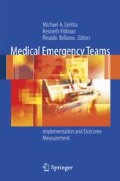Abstract
To mount an effective emergency response, medication and equipment resources must be available, reliable, and organized in a way to make them easily usable. Staff must be trained adequately so that they know what their resources are and how to manage them. Standardizing the equipment and medications contributes to a safe system by improving a number of logistic issues, including staff training, performance, error reduction, equipment maintenance and replacement after a crisis, and finally the institution’s ability to revise medication and equipment resources for crises. We believe that improving efficiency and reliability can reduce delays and errors, and contribute to the primary goal of improving patient outcomes following a crisis event.
Access this chapter
Tax calculation will be finalised at checkout
Purchases are for personal use only
Preview
Unable to display preview. Download preview PDF.
References
Abella BS, Alvarado JP, Myklebust H, et al. Quality of cardiopulmonary resuscitation during in-hospital cardiac arrest. JAMA. 2005;293:305–310.
Cummings RO, Hazinski, F. Guidelines for cardiopulmonary resuscitation and emergency cardiovascular care. Currents. AHA, Fall 2000.
Joint Commission on Accreditation of Healthcare Organizations (JCAHO). 2005 Comprehensive Accreditation Manual for Hospitals: The Official Handbook (CAMH). Oakbrook Terrace, Illinois: Joint Commission Resources; 2005.
Lighthall GK, Barr J, Howard SK, et al. Use of a fully simulated intensive care unit environment for critical event management training for internal medicine residents. Crit Care Med. 2003;31:2437–2443.
Tham KY, Evans RJ, Rubython EJ, et al. Management of ventricular fibrillation by doctors in cardiac arrest teams. BMJ. 1994;309:1408–1409.
Author information
Authors and Affiliations
Editor information
Editors and Affiliations
Rights and permissions
Copyright information
© 2006 Springer Science+Business Media, Inc.
About this chapter
Cite this chapter
Delgado, E., Grbach, W.J., Kowiatek, J., DeVita, M.A. (2006). Equipment, Medications, and Supplies for a Medical Emergency Team Response. In: DeVita, M.A., Hillman, K., Bellomo, R. (eds) Medical Emergency Teams. Springer, New York, NY. https://doi.org/10.1007/0-387-27921-0_19
Download citation
DOI: https://doi.org/10.1007/0-387-27921-0_19
Publisher Name: Springer, New York, NY
Print ISBN: 978-0-387-27920-6
Online ISBN: 978-0-387-27921-3
eBook Packages: MedicineMedicine (R0)

